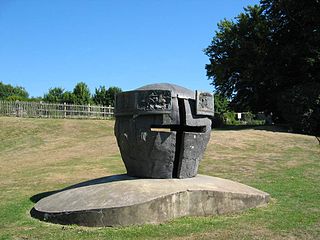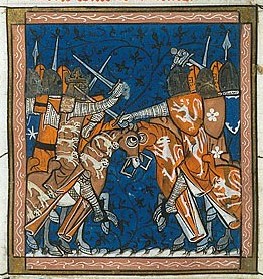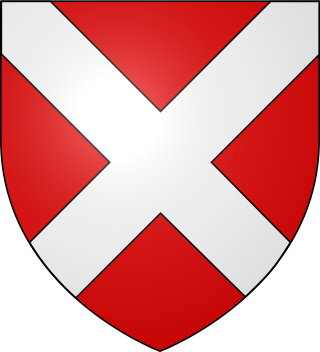
The Dictum of Kenilworth, issued on 31 October 1266, was a pronouncement designed to reconcile the rebels of the Second Barons' War with the royal government of England. After the baronial victory at the Battle of Lewes in 1264, Simon de Montfort took control of royal government, but at the Battle of Evesham the next year Montfort was killed, and King Henry III restored to power. A group of rebels held out in the stronghold of Kenilworth Castle, however, and their resistance proved difficult to crush.

Year 1264 (MCCLXIV) was a leap year starting on Tuesday of the Julian calendar.

Simon de Montfort, 6th Earl of Leicester, later sometimes referred to as Simon V de Montfort to distinguish him from his namesake relatives, was an English nobleman of French origin and a member of the English peerage, who led the baronial opposition to the rule of King Henry III of England, culminating in the Second Barons' War. Following his initial victories over royal forces, he became de facto ruler of the country, and played a major role in the constitutional development of England.
The Battle of Evesham was one of the two main battles of 13th century England's Second Barons' War. It marked the defeat of Simon de Montfort, Earl of Leicester, and the rebellious barons by the future King Edward I, who led the forces of his father, King Henry III. It took place on 4 August 1265, near the town of Evesham, Worcestershire.

Eleanor de Montfort, Princess of Wales and Lady of Snowdon was an English noblewoman and Welsh princess through her marriage to Llywelyn ap Gruffudd, who was Prince of Gwynedd, and later, Prince of Wales. She was the daughter of Simon de Montfort, 6th Earl of Leicester and Eleanor of England. She was also the second woman who can be shown to have used the title Princess of Wales.
Edmund, 1st Earl of Lancaster, also known as Edmund Crouchback, was a member of the royal Plantagenet Dynasty and the founder of the first House of Lancaster. He was Earl of Leicester (1265–1296), Lancaster (1267–1296) and Derby (1269–1296) in England and Count Palatine of Champagne (1276–1284) in France.

Roger Mortimer, 1st Baron Mortimer of Wigmore, of Wigmore Castle in Herefordshire, was a marcher lord who was a loyal ally of King Henry III of England and at times an enemy, at times an ally, of Llywelyn ap Gruffudd, Prince of Wales.

William de Valence, born Guillaume de Lusignan, was a French nobleman and knight who became important in English politics due to his relationship to King Henry III of England. He was heavily involved in the Second Barons' War, supporting the king and Prince Edward against the rebels led by Simon de Montfort. He took the name de Valence after his birthplace, the Cistercian abbey of Valence, near Lusignan in Poitou.

The Second Barons' War (1264–1267) was a civil war in England between the forces of barons led by Simon de Montfort against the royalist forces of King Henry III, led initially by the king himself and later by his son, the future King Edward I. The barons sought to force the king to rule with a council of barons, rather than through his favourites. The war also involved a series of massacres of Jews by de Montfort's supporters, including his sons Henry and Simon, in attacks aimed at seizing and destroying evidence of baronial debts. To bolster the initial success of his baronial regime, de Montfort sought to broaden the social foundations of parliament by extending the franchise to the commons for the first time. However, after a rule of just over a year, de Montfort was killed by forces loyal to the king at the Battle of Evesham.

Sir Henry de Montfort was the son of Simon de Montfort, 6th Earl of Leicester, and with his father played an important role in the struggle of the barons against King Henry III. Henry's mother was Princess Eleanor of England, a daughter of King John, whose marriage to Simon further increased the foreign influence begun by the king, which was to result in great hostility by those very barons who later revolted against the king.

Humphrey IV de Bohun, 2nd Earl of Hereford, 1st Earl of Essex was an Anglo-Norman nobleman and soldier who served as hereditary Constable of England.

Simon de Montfort's Parliament was an English parliament held from 20 January 1265 until mid-March of the same year, called by Simon de Montfort, a baronial rebel leader.

The Oxford Parliament, also known as the Mad Parliament, assembled in 1258 during the reign of Henry III of England. It is best known for the Provisions of Oxford, a set of constitutional reforms that forced the English king to govern according to the advice of a council of barons.
John Giffard, Baron Giffard of Brimsfield (1232–1299) was an English nobleman prominent in the Second Barons' War and in Wales. His initial gift of land in Oxford led to the foundation of Gloucester College, Oxford.
This article is about the particular significance of the century 1201–1300 to Wales and its people.
Events from the 1240s in England.
Events from the 1220s in England.

The Mise of Amiens was a settlement given by King Louis IX of France on 23 January 1264 in the conflict between King Henry III of England and his rebellious barons, led by Simon de Montfort. Louis' one-sided decision for King Henry led directly to the hostilities of the Second Barons' War.

The Mise[a]of Lewes was a settlement made on 14 May 1264 between King Henry III of England and his rebellious barons, led by Simon de Montfort. The settlement was made on the day of the Battle of Lewes, one of the two major battles of the Second Barons' War. The conflict between king and magnates was caused by dissatisfaction with the influence of foreigners at court and Henry's high level and new methods of taxation. In 1258, Henry had been forced to accept the Provisions of Oxford, which essentially left the royal government in the hands of a council of magnates, but this document went through a long series of revocations and reinstatements. In 1263, as the country was on the brink of civil war, the two parties had agreed to submit the matter to arbitration by the French king Louis IX. Louis was a firm believer in the royal prerogative, and decided clearly in favour of Henry. The outcome was unacceptable for the rebellious barons, and war between the two parties broke out almost immediately.

Robert de Neville, 2nd Baron Neville of Raby, was a medieval English nobleman.












